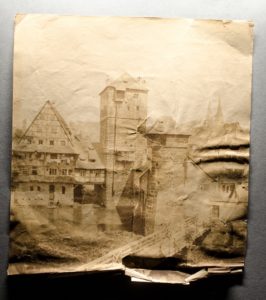This article is about a conservation treatment of a teared photograph belonging to the École Nationale Supérieure des Beaux-Arts de Paris (ENSBA).
When I received this print, I had little information about it. The ENSBA did not know the author, the depicted city, nor the picture and printing dates. I identified the print’s technique as an albuminised salted paper print, which allowed me to date the photograph.
Historical and technical background
Albuminised salted paper prints made the transition between salted paper prints (1840-1855) and albumen prints (1850-1900).
Salted paper prints were invented by W. H. Fox Talbot in 1839, first to be used as negatives, then used for printing positives. It is made of a sheet of paper, sensitized with silver chloride salts. It is a “printing out print” (POP), which means that the image appears directly from exposure to the light (unlike silver gelatin “developing out prints” – DOP).
The use of albumen, from egg whites, for photographic printing was introduced by L. D. Blanquart-Evrard in 1950, as an improvement of the salted paper. The paper was coated with an albumen layer containing the light sensitive silver chloride salts. The result is a semi-glossy print with better image definition, density and contrast.

For an albuminised salted paper print, albumen is used as an additional binding agent and is mixed with the salt (sodium chloride) bath. It is not a separate layer. As a result, the prints show a slight sheen on both front and back. This printing technique has been in use mostly in Europe.
With the historical information we know about the photographic process used to print this image, we can say that the print was made around 1850-1855.
Note: If you would like more articles about photographic techniques, let me know in the comments. In the meantime, you can check out the Graphic Atlas.
Damages
One can separate the damages present on this photograph in two main categories: the chemical damages and the mechanically induced damages, during manipulations.
Chemical damages

First, the prints shows an important fading and yellowing. These damages are more noticeable where the print has been retouched, because the original inpainting dots are of a darker tone than the image. These dots give us an idea of what the original image tone may have been. We need to be cautious as the inpainting material colour may also have shifted!
The causes for yellowing and fading are diverse and it cannot always be known with certainty which is responsible. Possible causes include poor processing (fixing and washing of print when it was made), high relative humidity, light exposure, air pollutants, or a combination of the above.
Mechanical damages

The second type of damages were made by the manipulations of the print throughout its history. The bottom edge has been folded numerous times and the paper has become brittle, creating loose fragments of print.
This photograph has also been teared several times. The two major tears are 20 cm long and located in the middle of the print. The tears have been repaired with gummed paper strips at the back. When it was repaired, the water based Arabic gum adhesive brought humidity to the paper, which created tensions between the two materials and resulted in wrinkling of the print.
These damages are very easily visible under raking light.
Conservation treatment
Cleaning
he first step of a conservation treatment is always cleaning. If one does a water or solvent based treatment on a dirty print, the dirt will sink into the materials and will not be removed.
With this print, most cleaning techniques were disrupting the albumen and changing the overall sheen, so some stains could not be removed. Preserving the sheen is important because it is part of the original photographic technique.
Removal of old repairs
Once the print was cleaned, I proceeded to remove the reinforcing gummed paper. As mentioned previously, the Arabic gum is an aqueous adhesive, which means it is sensitive to water. As a result, I used a water-based poultice to soften the adhesive and removed the reinforcing paper strips.
Tear repair and infills
After removal of the reinforcing paper strips, the middle piece between the two 20 cm tears is mostly flat. It is also still attached to the rest of the print by 0.5 cm. As a result it was simpler to glue back in its original place.
Once all the tears were repaired and reinforced at the back. I made and added a small infill piece for the missing part on the right edge.
At this point, the teared photograph has been repaired and infilled but the paper is still very brittle and fragile. As a result, I decided to line it with a very thin Japanese paper to give it some support. The treatment was finished by flattening the print.
In conclusion, this treatment was very rewarding because there is a huge visual difference between before and after treatment, which is not always the case for photograph conservation treatment.
I hope you enjoyed reading this article. Let me know in the comments if you have any questions about this treatment and I will answer as soon as I can.
You have a teared photograph? Contact me, I can help you.















If surface cleaning (some moisture based?) were disturbing the surface of the photograph, how did you go about lining it?
Hello Amanda, Thank you for your comment. The lining was made with Klucel G diluted in ethanol to avoid the use of water which disturbed the gloss. I did preliminary tests to confirm that ethanol would not affect the gloss before proceeding with the treatment with Klucel G. Feel free to send me an email if you have questions.